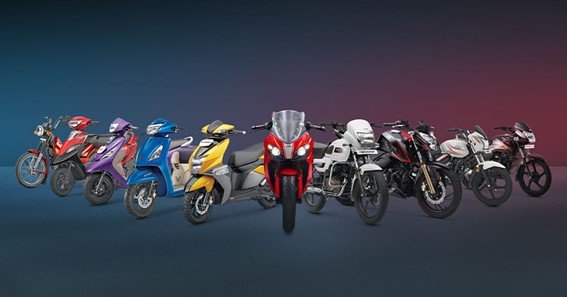The Indian motorcycle market is fiercely competitive, with Bajaj Auto Ltd and TVS Motor Company Ltd as two major players. Both companies have unique strengths, but they are taking different approaches to capturing market share. Let’s take a deeper look at how these two giants compare in terms of market strategy, performance, and future growth.
Market Share & Sales Performance
As of 2023, TVS Motor holds approximately 17% of the domestic two-wheeler market, while Bajaj Auto maintains around 12%. TVS has been growing its market share, especially in the scooter and premium motorcycle segments, thanks to successful launches like the Jupiter, Ntorq, and iQube electric scooters. Bajaj Auto, on the other hand, excels in the premium motorcycle segment, driven by its partnerships with brands like KTM and Triumph.
In terms of growth, TVS recorded a 28% increase in domestic sales in February 2023, whereas Bajaj Auto saw a decline of 16% during the same period. This gap highlights TVS’s stronger footing in the Indian market, particularly in segments like scooters and electric vehicles (EVs), where Bajaj Auto lacks a significant presence.
Profitability and Margins
Although Bajaj Auto enjoys higher overall margins, largely due to its export business and premium pricing, TVS Motor has been steadily improving its operating margins. In FY23, TVS’s operating EBITDA rose to 11%, supported by higher sales volumes and a focus on premium products. In contrast, Bajaj Auto’s margins, though robust at over 15%, have come under pressure due to rising input costs and slowing exports.
The Electric Vehicle (EV) Battle
Both companies are making strides in the growing EV segment. TVS has a strong foothold with its iQube electric scooter, and it is aggressively expanding its EV offerings with partnerships and R&D investments. Bajaj Auto, meanwhile, is focusing on building its EV infrastructure and plans to roll out new models, though it has been slower to market than TVS.
International Presence
Bajaj Auto leads in exports, with 37% of its volumes coming from international markets. However, economic challenges in key regions like Africa and Asia have impacted its export growth recently. TVs, while having a smaller export footprint (around 22% of volumes), are gradually expanding into new markets.

Conclusion
In the short term, TVS Motor appears to have the edge in terms of domestic growth and a more aggressive push into the electric vehicle space. However, Bajaj Auto remains a strong player, especially in the premium motorcycle and export markets. Over the long term, Bajaj’s potential for margin growth and international expansion could help it catch up to TVS, but for now, TVS has the upper hand in the domestic two-wheeler market.
FAQ
1. Who has a bigger market share, Bajaj Auto or TVS Motor?
As of 2023, TVS Motor holds around 17% of the domestic market, while Bajaj Auto holds 12%.
2. Which company is leading in electric vehicles?
TVS Motor is ahead with its iQube electric scooter, while Bajaj Auto is still expanding its EV lineup.
3. How does Bajaj Auto fare in exports compared to TVS Motor?
Bajaj Auto leads in exports, with 37% of its sales coming from international markets, compared to 22% for TVS.
4. Which company has better profitability?
Bajaj Auto enjoys higher overall margins, but TVS is catching up with improvements in operating EBITDA.
5. Who is better positioned for long-term growth?
TVS appears stronger in the domestic market and EV space, while Bajaj Auto has greater potential in international markets.
